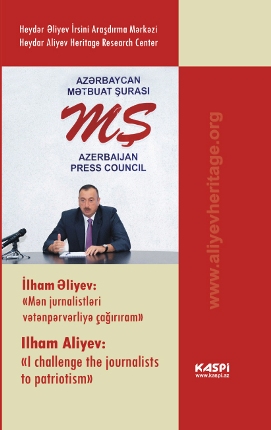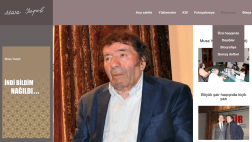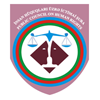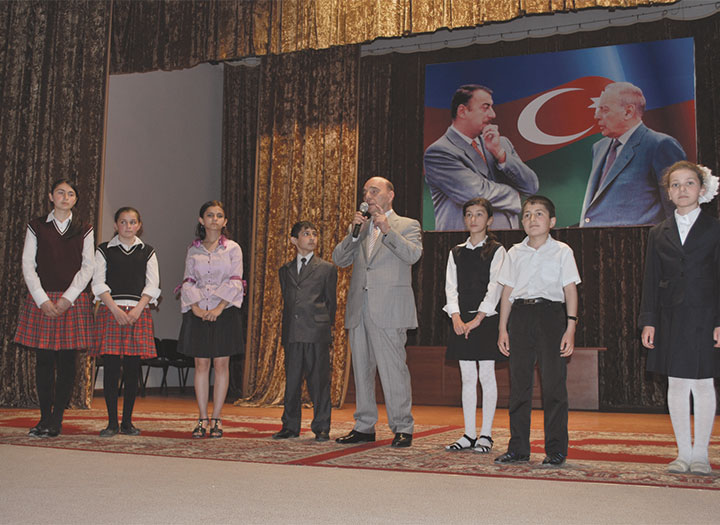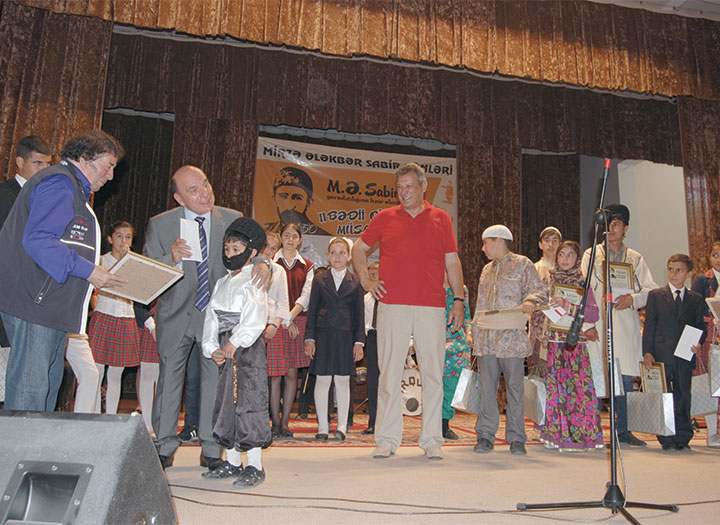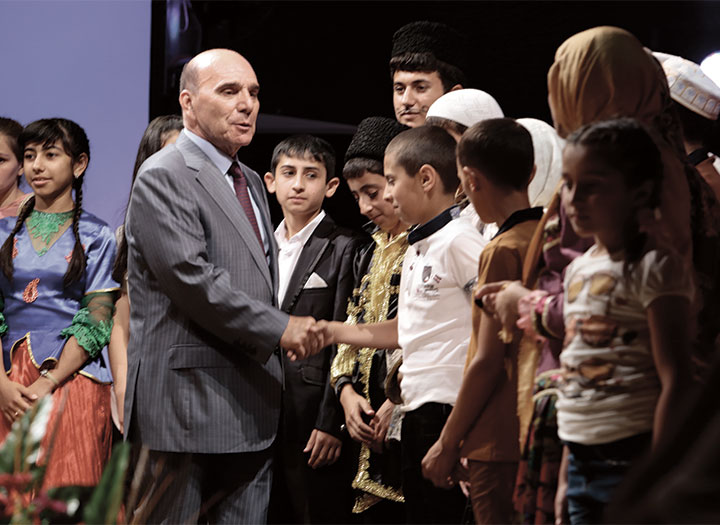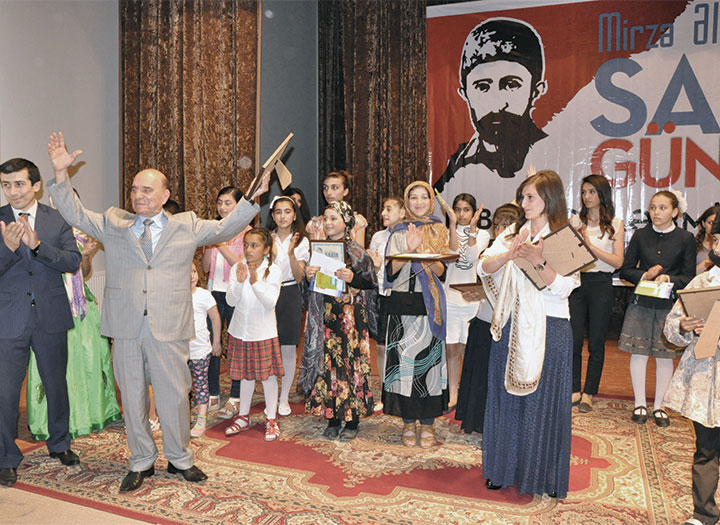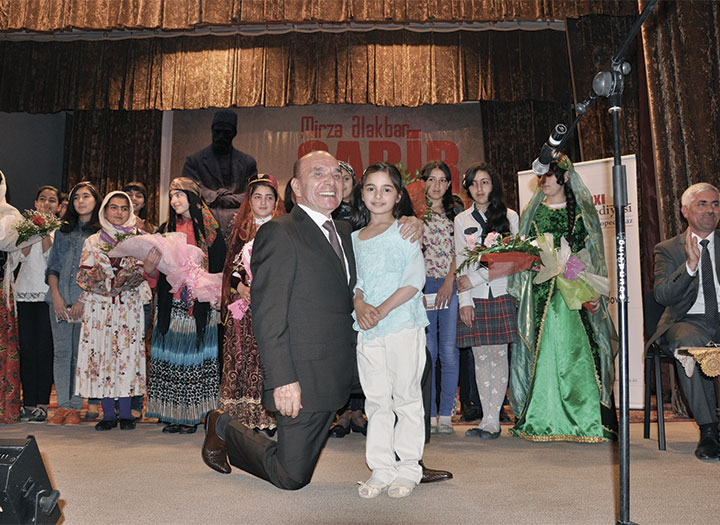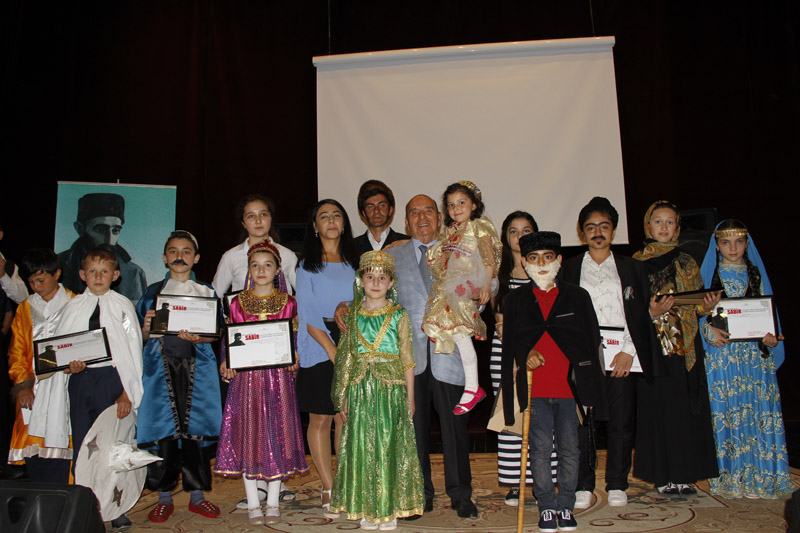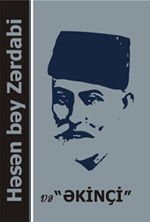 The influential Israeli newspaper Israel Hayom has published an article entitled “Azerbaijan – the Holy Land of Fire”. AZERTAC presents the article.
The influential Israeli newspaper Israel Hayom has published an article entitled “Azerbaijan – the Holy Land of Fire”. AZERTAC presents the article.
An excursion through the streets of the beautiful city of Baku will make you disconnect from the permanent image of the Caucasus as the eastern part of the West. Next week, a Formula 1 race will be held in the capital of Azerbaijan, and the city is preparing for the important international sporting event. While in Baku for several hours, we see beautiful modern architectural buildings, huge palaces, broad and illuminated avenues, restaurants on all sides, cafes and bars with prices affordable for any Israeli tourist visiting Azerbaijan.
We, Israeli journalists, came here to see, understand and take a closer look at the territorial conflict Azerbaijan has been suffering from for the past 30 years. We saw a difficult state of the country suffering from occupation, a country the name of which means “a land that keeps fire”.
Baku: from harmony to the heart of the conflict
We have come to the majestic Heydar Mosque, the four minarets of which rise to a height of 95 meters. When the Sun illuminates this architectural miracle, it is difficult not to feel the religious power of the Universe towering above life. The mosque is named after the national leader of the country, the legendary President of Azerbaijan Heydar Aliyev. The mosque has three floors where women also pray, can accommodate 3,500 people, but the most surprising thing we find in the mosque is not the huge carpet of 900 square meters, which immediately catches the eye at the entrance, but the rare and unique religious harmony of this remarkable country that cannot be seen or felt elsewhere in the world.
Two imams meet us at the entrance to the mosque – Hafiz Abbasov (Shiite) and Akhund Rauf (Sunni), as well as other high-ranking representatives of religious denominations, including the head of the Mountain Jews and the head of the Albanian Catholic Church. The Azerbaijanis are very proud to be the first secular parliamentary country of the Islamic world where religion and state are completely separate.
Such harmony can exist between people of all religions (there are 955 registered religious organizations operating in the country), which is both strange and quite logical. “The reason it works and the fact that there is harmonious religious and national tolerance lies in the fact that Azerbaijan has always been a unique place for multiculturalism,” explains Ravan Hasanov, head of the Baku International Center for Multiculturalism. “Due to its geographical location at the crossroads of cultures and religions, representatives of many nationalities and religions live in Azerbaijan, while the policy of multiculturalism has been raised to the level of official state policy. President of Azerbaijan Ilham Aliyev treats representatives of all religions equally and conducts a very wise policy which promotes unity, peace and calm between peoples and confessions.”
We leave comfortable Baku and its lit up nights and drive along straight roads to the border of the territories of Azerbaijan occupied by Armenia – the bleeding wound in the heart of the Land of Fire which physically tears it into two.
The landscape is homogeneous, there is black and fertile soil, several agricultural settlements and road stations, domestic animals on the roadside and, above all, somewhere on the horizon, distant mountains rise as a threat from above. In the chaos that arose before the collapse of the Soviet Union in 1988, ethnic conflicts erupted between the Armenian and Azerbaijani population in the South Caucasus region. It is a historical fact that 250,000 Azerbaijanis were expelled from Armenia. In February 1992, Armenian armed forces committed mass slaughter and killed 613 civilians in the Azerbaijani city of Khojaly in one night. As a result of the ethnic cleansing carried out by Armenia, 750,000 Azerbaijanis were expelled from their own lands in Nagorno-Karabakh and seven adjacent districts.
Tartar District: human sadness on the border
Four kilometers from the border with the occupied territories of Azerbaijan, we are met by the friendly head of Tartar District Mustagim Mammadov.
When Mammadov tells us that during the military operations rockets landed in Tartar from all sides, we felt like in Israel.
The head of the district took us to the “Maraga” monument erected by the Armenians to mark the 150th anniversary of their resettlement to the territory of Azerbaijan from Iran and Turkey. Winning the Russian-Iranian war, Russia carried out a massive resettlement of Armenians to the territory of Azerbaijan. Most Armenians were resettled to the mountainous part of the ancient region of Azerbaijan.
These events are explicitly confirmed by a number of irrefutable facts. One of the most significant ones is the monument erected in the village of Maraga of Aghdara District of Karabakh in 1978 to mark the 150th anniversary of the resettlement of Armenians to the village of Maraga from Iran. When the Armenians left, they destroyed this historical monument.
A sense of historical justice is the source of strength for the Azerbaijanis who speak about the conflict with Armenia with pain in their hearts. During our visit, they told us the story of their country time and again, including the campaign of Alexander the Great to this region. We heard from people that the region’s largest water reservoir Sarsang located on the Tartar River in Nagorno-Karabakh occupied by Armenia allows for the accumulation of up to 560,000 cubic meters of water. In Soviet times, these resources were allocated to irrigate about 130,000 hectares of farmland. During the war of 1992-1994, fierce battles were fought for the possession of the reservoir. As a result, Armenia occupied the territory, controls the reservoir now and blocks water resources for Azerbaijani farmers and agricultural lands. As a result of the occupation, agriculture significantly declined, and in order to prevent a crisis, the Azerbaijani government provides economic benefits to this region by allocating the necessary subsidies for the development of this sphere. Instead of the water sources of the Sarsang reservoir, Azerbaijani farmers irrigate their farmland with artesian water, which they raise from under the ground with great difficulty.
This is the economic cost of the conflict for Azerbaijan, which produces cheap agricultural products with huge investments derived from the country’s oil and gas revenues. That is what I understood from a conversation with Foreign Minister of Azerbaijan Elmar Mammadyarov, who first of all expressed his admiration with the opportunities and technological capabilities of Israel in the field of water management. When I asked the head of Tartar District whether young people were leaving this agricultural periphery for the big city, Mustagim Mammadov said: “Everything you see in Baku, we have here, perhaps even more”.
We are going to the village of Hasangaya. In 2016, in the run-up to the four-day April war, a 16-year-old Turana Hasanova was killed by artillery fire from Armenian armed forces. The young girl became a victim of Armenian occupiers. We meet her parents. They tell us everything that happened with great pain and sadness in their eyes. They show us the brother of the deceased – a 32-year-old Azad Hasanov who hit an anti-personnel mine on the line of contact. His leg was amputated. The sight of the ruins is heartbreaking, we empathize and understand the misfortune and sadness experienced by people driven out of their own lands.
Lalatapa: between two mountains
“At the beginning of April 2016, the Armenians, as always, carried out their usual provocations on the front line at night, but this time we decided to respond firmly and with great force,” says Major Tahir, who, unlike many soldiers we met, looked very confident and smiled. “The Lalatapa height we freed provides our forces with the opportunity to observe and exercise fire control over the Horadiz settlement, the area around it, further in the direction of Fuzuli, and removes the threat of an important railway junction of Horadiz being fired on by the enemy. It also prevents the enemy from the opportunity to covertly concentrate and advance in this direction.” The Lalatapa operation for the Azerbaijanis is the equivalent of Israel’s conquering Mount Hermon, a battle that is a source of pride for all the Israelis.
We sit at Lalatapa with soldiers and traditionally drink the hot and strong Azerbaijani tea with incredibly tasty jams, a ceremony no Azerbaijani host will let you do without. I sit and watch over this valley, look down and understand that the Lalatapa summit dominates a vast territory. Because of the winding terrain, natural obstacles and sharp artificial bends, even a brand-new Japanese jeep will find it difficult to climb the hill. In 1993, the Armenians seized this mountain peak, creating a fortified position – almost impenetrable and almost invincible.
Azerbaijani soldiers and officers are proud to have liberated the fortified complex in a matter of 20 minutes. The topography around the outpost shows that they were superheroes of their country. As a part of the Israel Defense Forces, I simply admire the courage of Azerbaijani soldiers. I try to understand how the battle unfolded and how Azerbaijani superhero soldiers managed to capture the fortified Armenian outpost. After a long time, I discovered that according to foreign media, Israeli military technology no-one likes to talk about, helped courageous Azerbaijani soldiers and their heroism.
Ashagi Abdurahmanli
In this village, we met with the president of the International Eurasian Press Foundation, deputy chairman of the Press Council of Azerbaijan, Umud Mirzoyev, who offered to take us to his former village now destroyed by the Armenians. This elderly and bright-hearted person moved us to tears. “My school was here, my home was here, this was the home of my wife’s parents, this is where we played football as kids.” When we approach a beautiful green hill, he adds, “Here I fulfilled my father’s will. When he was dying, he asked me to bury him in our village, on our land. He told me, “My son, the process of liberation of Azerbaijani lands has begun, and I believe that all our lands will be freed in the near future, so bury me in our village.”
We walked through the ruined village and saw destroyed houses, schools and smashed tombstones. The tombstones were barbarously disfigured. This is something horrific – Armenian snipers deliberately shoot even the dead. The soldiers accompanying us ask Umud to bend down, but the emotional Umud refuses and, standing before the grave, declares his loyalty and devotion to his land, the land of his great-grandfather, grandfather and father, his country and the Azerbaijani people.
Jojug Marjanli
“I am no hero, I stayed here because this is my land,” says Ogtay who, despite his modesty, is definitely a local hero. “Between 1994 and 2016, Armenian armed forces fired on our village almost every day. It was clear to the local people that this was a psychological war with the use of live ammunition. The Armenians turned this famous village of Jojug Marjanli into a living firing range for their soldiers from the Lalatapa post.”
In this difficult situation, more than 1,000 rural residents temporarily left their homes and lands and moved to safer and more peaceful places. The last person who stayed behind and even refused to be evacuated was our humble hero Ogtay. For 22 years, he continued to work on his land and raise children, started his own farm despite the constant danger to life. His children attended school in a distant village. I asked if the friends of his children came to play in this abandoned and forgotten village. Ogtay smiled ironically, “Kids will be kids – of course, they came here.”
After a complete defeat of the Armenian occupying forces in the battle of Lalatapa, the Azerbaijani government and state restored the village. As a result, there is a beautiful, I would say even a fantastic village now.
The whole village serves as an excellent illustration of the past. The walls of a local school are decorated with photos of national heroes who gave their lives for the liberation of this village during the battle. I understand why it was so important for the Azerbaijani people that we, Israeli journalists, see this village, because there is nothing more important for them today than the living narrative telling their story as a phoenix which rose from the Soviet ashes and restores its future.
It is hard not to feel the hypocrisy of the world if we compare the history of the refugees and internally displaced persons living throughout Greater Azerbaijan with the Israeli-Palestinian conflict. While the Palestinians do not let go of the rusty keys to the homes of their great-grandmothers and grandfathers, and the world is buzzing around them in headlines, the Azerbaijanis ask for very little – world attention. They want the world to know about the occupation of Azerbaijani territories, the problems of one million refugees and internally displaced persons from Nagorno-Karabakh and seven adjacent districts of Azerbaijan.
More importantly, the Azerbaijanis want the world to pay attention not only to the catastrophe of the Azerbaijani people, but also to the restoration and rehabilitation of the de-occupied territories provided by the state, especially to the fact that they are trying to resolve the interethnic conflict without fomenting hatred between nations.
Time and again, our Azerbaijani friends proudly tell us that despite the ethnic cleansing by the Armenians and the destruction of all mosques in Armenia and Nagorno-Karabakh, the Azerbaijanis not only did not expel the Armenians living in Azerbaijan, but even restored and repaired the Armenian Church located not far from the Old City in the very center of Baku. We personally witnessed that.
As Zamin, the principal of a school in Jojug Marjanli, summed up, “I do hate the Armenian soldiers occupying my land, but I do not hate the Armenian people as a whole.”
So where is all this going? During our trip, a meeting of the foreign ministers of Azerbaijan and Armenia was underway in Moscow. It seems that the Azerbaijanis are not interested in continuing the conflict.
Arye Gut, an expert on Israeli-Azerbaijani relations, explains the position of Azerbaijan, according to which diplomats hide behind the words. “It is a fact that more than 20 percent of Azerbaijani territory is under Armenian occupation. This is illegal occupation. There are four resolutions of the UN Security Council that do not recognize Armenian occupation and control over these territories.
Despite the clear calls by international organizations for the Republic of Armenia to withdraw its troops from Nagorno-Karabakh and seven adjacent districts of Azerbaijan, Armenian forces continue to occupy Azerbaijani territories, continue to shoot and violate the ceasefire.
However, Baku is also trying to resolve the issue peacefully. Everyone understands that without the support of a third country, the poor Armenia could not occupy 20 percent of the territory of Azerbaijan. And the patience of Azerbaijan is at its limit. Baku has repeatedly stated and warned Armenia that it will never put up with the existing status quo. However, the delusional statements by the military and political leadership of Armenia are evidence of their concern, fear and panic.”
These words of the Israeli expert confirm the words of a young schoolchild from the borderline Tartar District I met when he was supposed to take an examination for the certificate of maturity. When asked how this conflict would end, he replied: “We have no intention to lay claim to the lands of others. The lands occupied by Armenia are ours and we will never abandon them. If necessary, we will fight and, in the end, they will surrender or pay with blood,” said the Azerbaijani schoolboy.
Departure from Baku: towards democracy
The Azerbaijanis understand the geopolitical map of the region very well. During the visit, we always hear their great appreciation to Israel for its support. We heard this during a meeting with the Azerbaijani President’s Assistant for Public and Political Affairs Ali Hasanov. “Azerbaijan considers Israel to be a friendly country and a strategic partner. Just a few days ago, early parliamentary elections were held in Israel, and the current Prime Minister, Benjamin Netanyahu, won for the fifth time and headed the government. We have great respect for the choice of the Israeli people. Netanyahu was the first senior Israeli official who visited Azerbaijan in 1997 and met with Heydar Aliyev.
Our special strategic relationship began after that historic visit by the Israeli Prime Minister. Then Benjamin Netanyahu paid his first working visit to Azerbaijan in December 2016, thereby demonstrating a course for the further closeness between Baku and Tel Aviv. We treat the Israeli head of government with great reverence and respect. We are aware of the warmth and respect Benjamin Netanyahu has for our country and President.
Today, the relations between Azerbaijan and Israel are successfully developing in all areas. I also want to note that 65 percent of the oil consumed in Israel comes from Azerbaijan, which is the most important buyer of Israeli high-tech products.
We will continue to work on strengthening and deepening the relations between Israel and Azerbaijan in all fields.”
Our last meeting in the capital of Baku was with the Head of the Foreign Policy Affairs Department of the Presidential Administration of Azerbaijan Hikmat Hajiyev. During the meeting Hajiyev told us about the unique status of Azerbaijan at the beginning of the 21st century and the strategic importance of relations between our two countries.
“Since the restoration of state independence in 1991, Azerbaijan has developed special relations with Israel. Israel was one of the first countries to recognize our independence. We have excellent economic, political, military, cultural and trade relations. There are direct flights, which proves that there are excellent and stable relations. Just before Pesach, 1,000 Israeli tourists flew “Azerbaijan Airlines” from Tel Aviv to Baku in just one day.”
When we ask him about the democratic reforms in Azerbaijan, Hikmat Hajiyev rightly answers. “We are on course to becoming a democratic state. Not every country is adaptable to the same democratic model. Our democracy is only 27 years old. Democracy is a state of consciousness, and if you look at civil rights, religious rights, and political rights, you will find that Azerbaijan sometimes suffers from an unfair image. Therefore, we appreciate those of you who come here to get acquainted with the country, understand the country’s problems, objectively evaluate them and see the truth.”
Hikmat Hajiyev enthusiastically told us about the opening of a kosher restaurant in Baku, which once again underlines and shows how important Israeli tourism is, as well as the technologies that Israel provides to Azerbaijan – from agriculture and medicine to modern weapons.
“Azerbaijan has a place on this geopolitical map, and I always jokingly say that if you look at the map, my country looks like a bird flying from east to west. So if you tear off one wing, it will not be able to fly. This is why we say that we need both wings,” says Hikmat Hajiyev, Head of the Foreign Policy Affairs Department of the Presidential Administration of Azerbaijan.
